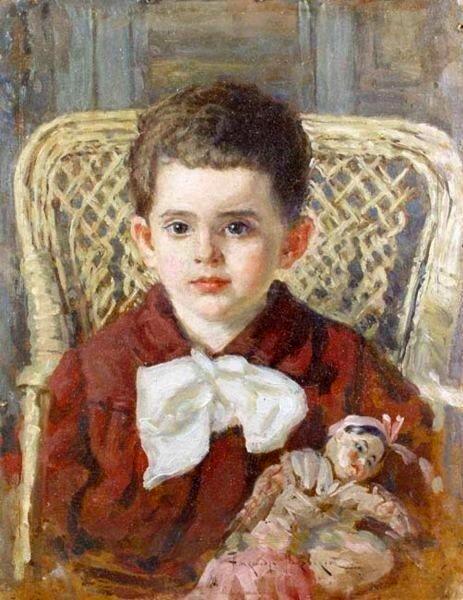
Artists Illustrating Boys' Fashions: Aleksandr Vladimirovich Makovsky (Russia, 1869-1924)

Figure 1.--This Aleksandr Vladimirovich Makovsky portrait is said to be of an English boy painted in 1922, but he is not named. His outfit is unusual. It looks more French than English to us. We would guess he is wearing a smock with a large white floppy bow. He looks to be about 6 years old and is holding a girl doll. Whether the boy was living in Russia at the time is speculation, but as far as we know, Makovsky never painted abroad. We are not sure what the boy's parents were doing in Moscow. Britain did not recognize the Soviet Union until 2 years later (1924). During the Civil War it would have been very dabgerous for British subjects to be in the country unless they were revolutionaries.
|
|
Aleksandr Vladimirovich Makovsky was a noted Russian painter. He was born in Moscow (1869). His father was the son of the artist Vladimir Makovsky. Aleksander studied at the Imperial Academy of Arts at Saint Petersburg (1894-95).
He also studied in Moscow School of Painting, Sculpture and Architecture. His career is primarily associated with Tsarist Russia, but he lived through the Revolution and early Soviet period. He was an active member in the Moscow Association of Artists (MTKh) (1890s). Makoovsky next began exhibiting with the Itinerant Movement (turn-of-the 20th century) and becane very active in the movement (1900s-1910s). We notice a range of portraits and genre scenes as well as still lifes. His 'Easter table' is particularly evocative. About the same time he began his association with the Itinerists, he started teaching at the Imperial Academy of Arts (1898). He was appointed a full academic there (1911). He ended his association with the Itinerists (1922). He then joined the Association of Artists of Revolutionary Russia (AKhRR) (1924). Makovsky died the same year. We note a portrait he did of an English boy in Moscow (1922). We are not sure what his parents were doing in Moscow. Britain did not recognize the Soviet Union until 2 years later (1924). During the Civil War it would have been very dangerous for British subjects to be in the country unless they were revolutionaries.
A reader writes, "On the wall of rememberance behind Lenin's mausoleum are plaques to two British men who served in the revolution and afterwards. I have never found out who these British men where or what they did. I was not allowed to take photographs. Maybe there is a connection to this painting."
HBC

Navigate the Boys' Historical Clothing Artists pages:
[Return to Main Russian Artists page]
[Return to Main Artists M-R page]
[Chronology]
[Countries]
[Individuals]
[Styles]
Navigate the Boys' Historical Clothing Web Site:
[Introduction]
[Activities]
[Biographies]
[Chronology]
[Clothing styles]
[Countries]
[Bibliographies]
[Contributions]
[FAQs]
[Glossaries]
[Images]
[Links]
[Registration]
[Tools]
[Boys' Clothing Home]
Created: 9:37 PM 3/19/2011
Last updated: 9:38 PM 3/19/2011



